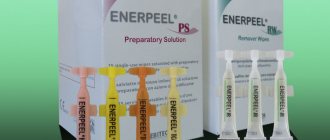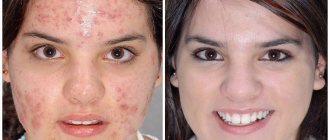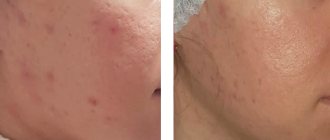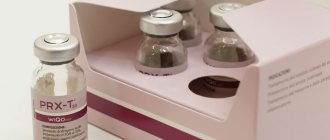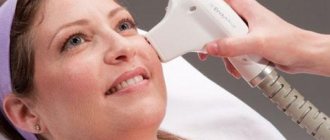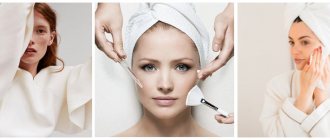- Indications
- Contraindications
- Peculiarities
- Kinds
- Stages
- Actions
- Side effects
- Rehabilitation
- Independent use
- pros
- conclusions
The cosmetology market offers various types of peelings for skin renewal. One of the most promising pharmaceutical agents is azelaic acid, which is included in many medications and, through chemical exfoliation, eliminates skin imperfections and initiates natural rejuvenation processes. The procedure has variations that are taken into account depending on the initial state of the epidermis and the expected results.
What is combined peeling
Combined peeling most often means that a composition of various chemical ingredients is used for manipulation, due to which a multi-level and combined effect is achieved.
However, combined exfoliation in some cases involves the use of different cleaning options (for example, mechanical and hardware, or enzyme and hardware). When using such combinations, the effectiveness of the procedure increases significantly. The skin is simultaneously not only cleansed of accumulated rough cells, sebum, acne, comedones, but also rejuvenated by activating regeneration processes in the middle and deep layers of the dermis.
Benefits of azelaic acid for skin
- Has antibacterial and anti-inflammatory effects.
- Prevents the appearance of acne and sebaceous plugs.
- Reduces the risk of acne.
- Normalizes the production of subcutaneous fat.
- Whitens and evens out complexion.
Azelaine peeling can be prescribed for prevention, since this procedure not only treats, but also prevents the re-development of skin diseases.
The method of preparing the product yourself must be clarified with your treating cosmetologist - incorrectly selected proportions of various acids can lead to severe drying of the epidermis and burns.
Indications and contraindications for the procedure
Combined peeling is most often used in the presence of various combined pathologies of the skin:
- acne with pimples of varying degrees of maturity and depth of penetration;
- oily type of dermis, comedones and other characteristic defects;
- combination skin type, requiring a different approach to exfoliation;
- excessive stratum corneum and age-related changes in need of rejuvenation;
- signs of hyperkeratosis and pigmentation;
- thickening of dead surface epithelium and pale color of the integument due to impaired microcirculation and others.
In addition, combined peeling can be used as a preparation step for other aesthetic manipulations. Some conditions may not allow this type of skin cleansing. Contraindications include:
- pregnancy and lactation;
- skin infectious diseases;
- herpes;
- rosacea;
- oncological diseases;
- nevi, warts in the affected area;
- unfavorable allergy history.
Limitations also include some systemic pathologies, including connective tissue diseases (systemic lupus erythematosus, tendency to form keloid scars). The presence of chronic diseases of internal organs must be reported to the cosmetologist during the consultation before the manipulation. Knowing your condition, the doctor will be able to choose the optimal comprehensive exfoliation option for you. It is not recommended to carry out the procedure on menstruation days.
Carrying out at home
If you carry out azelaine peeling at home, the result will be less pronounced.
In addition, the risks of side effects increase. The reasons may be: lack of experience, the inability to get a complete picture of the state of health, and the wrong choice of remedy.
Before use, it is recommended to seek advice from a specialist.
When choosing a drug, it is better to take one with a neutral pH level.
Stages of the procedure at home:
- Apply the product to previously cleansed skin, strictly following the manufacturer's instructions.
- Treat the affected area with a neutralizer after the time indicated on the package. In case of severe burning, everything should be washed off immediately.
Contraindications:
- individual intolerance;
- pregnancy, lactation period;
- acne, herpes;
- oncological diseases;
- neoplasms in the area of influence.
The mask helps solve the problems of post-acne, scars, scars, age spots. It allows you to even out the texture of the dermis, lighten pigmentation, tighten facial contours, eliminate expression wrinkles, suppress bacterial activity and increase the barrier properties of the dermis. All of these effects are achieved by normalizing blood circulation, activating regeneration processes and enhancing collagen production.
ABR peeling
This is a combined medium peeling. It is one of the best care products for oily problem skin, often used to correct post-acne. The composition of the preparations includes: alpha- and beta-hydroxy acids, vitamin A. Due to alpha-hydroxy acid, dead particles are delicately dissolved, metabolic and regenerative processes in cells are activated.
Beta-hydroxylic acid exfoliates the stratum corneum and cleanses pores. It has keratolytic and anti-inflammatory effects. The presence of retinol helps fight free radicals. In addition, it promotes regeneration by stimulating collagenogenesis and regulates cell division.
Composition and action
First, let’s find out what it is – retinoic peeling. This is a type of chemical peeling that contains retinolic acid. It has a rich yellow color. This feature of the acid gave the procedure a second name – yellow peeling.
Retinolic acid is a synthetic analogue of retinol. In addition to this acid, the peeling includes ascorbic, azelaic, koic, and phytic acids. Any of them gives a positive effect for facial skin, as can be seen in the photo.
In terms of healing, yellow peeling is classified as superficial, and in terms of its effect on the skin, it is classified as medium. The first factor allows you to carry out a peeling course in the summer, at a time when other rejuvenation procedures are contraindicated.
But it should be noted that after the procedure you will have to forget about relaxing on the beach for a certain time. Retinolic acid, together with the other peeling components, has a stimulating effect, causing skin cells to divide more actively, which leads to the production of elastin and collagen and an effect on the deeper layers of the skin, helping to retain moisture.
In addition to rejuvenating the skin, retinoic peeling has a disinfecting effect and destroys the harmful effects of bacteria on the skin. This property helps to combat high oily skin. Retinol peeling receives expert reviews as the best prevention against skin diseases.
Indications:
- enlarged pores;
- acne, post-acne;
- signs of photoaging;
- premature withering of the dermis;
- hyperkeratosis;
- pigmentation;
- unhealthy complexion.
Contraindications:
- exacerbation of somatic pathologies;
- herpes virus infection;
- allergy to ingredients;
- atypical dermatitis, psoriasis, eczema;
- abrasions, scratches in the area of peeling;
- oncology.
Contraindications for this exfoliation also include mental and nervous disorders, periods of pregnancy and lactation, and taking medications containing retinol. It is not recommended to perform the procedure during menstruation.
ABR exfoliation allows you to reduce the number and depth of wrinkles, cleanse the skin of comedones, normalize metabolic processes and the activity of the sebaceous glands, accelerate tissue regeneration, and enhance hemodynamics. After peeling, the dermis is evened out, the complexion improves, becomes radiant and smooth. The procedure provides anti-inflammatory, antioxidant and rejuvenating effects.
Stage III. Post-peeling care is divided into early and late
The duration of the early rehabilitation period is 5–7 days. During the day, the patient should apply Vegelip or Vegefarma moisturizing cream, and MediScreen sunscreen in the morning. From the 30th day, it is recommended to apply Cimel Mantenimento cream, which contains retinol and kojic acid to help maintain the peeling effect.
Expected reactions
Bright erythema in the peeling area (similar to active tanning in a solarium) that persists for 2–4 days. Minor swelling of the treated area is possible. As a rule, swelling appears in patients with pasty, swelling-prone skin. 12–48 hours after peeling, depending on the severity of hyperkeratosis in a given patient, large-lamellar or small-lamellar exfoliation (peeling) is observed. 2–3 days after the procedure, the patient may be bothered by itching, as an individual reaction of the body to retinol. Peeling is possible in areas adjacent to the peeling zones. It is very important to inform the patient about this during the consultation. The rehabilitation period lasts 4–8 days.
Peeling programs
The basic course consists of 3–4 procedures, which are carried out at intervals of 1.5–2 months. The course is conducted 1-2 times a year.
Practical advice
- Pre-peel preparation is mandatory, since otherwise hyperkeratosis will interfere with the penetration of retinol and significantly reduce the effectiveness of chemical peeling.
- You should work with gloves, as skin reactions may occur upon contact with the drug.
- If there is a need for peeling of a large area, it is recommended to peel in areas not exceeding 10% of the total surface area of the human body skin, with an interval of 2 weeks.
- For patients with skin types IV and V according to Fitzpatrick, when treating hyperpigmentation, peeling is carried out strictly in the autumn-winter period.
- To speed up the desquamation process, while washing the skin, you can roll it with light finger movements. Abrasives (scrubs, brushes, etc.) should not be used, and the patient must be informed about this. Apply Vegelip or Vegefarma restorative cream for the first 10-20 days as discomfort appears. To optimize the peeling result from the 30th day until the next procedure, it is necessary to use Cimel Mantenimento post-peeling cream.
Azelaine peeling
This is a mid-superficial facial cleansing procedure using azelaic (carboxylic) acid and various additives. Often used for problematic skin and maintaining the aesthetic beauty of the face. The main component in the composition is azelaic acid, which helps suppress the production of melanin, reduce the secretion of the sebaceous glands, which eliminates rashes and whitens pigmentation.
In addition to carboxylic acid, the composition may include mandelic, lactic, salicylic, phytic and other acids in different proportions. The purpose of the peel depends on the ingredients included in it. This could be: fighting acne, lightening pigment, treating demodectic folliculitis, regulating sebum secretion and others.
Healing period
During the rehabilitation period you should:
- regularly moisturize the epidermis;
- treat your skin with sunscreen before going out;
- protect damaged skin from exposure to direct sunlight, wind and sudden temperature changes;
- Avoid visiting a solarium, open water, swimming pool or sauna for 2 weeks.
Compliance with these recommendations minimizes the risk of bacteria and other harmful microorganisms penetrating the skin. The average recovery time in the absence of complications is 14 days.
Contraindications:
- severe allergy history;
- pregnancy and breastfeeding;
- rosacea;
- inflammation, wounds in the dermis treatment area;
- oncological diseases;
- fresh tan
Dermatocosmetologists do not recommend using the technique during hormonal changes in the body: adolescence, pregnancy and menopause.
Azelaine peeling helps eliminate inflammatory processes, neutralize free radicals, smooth out wrinkles, smooth out surface relief, prevent the appearance of age spots and eliminate existing hyperpigmentation. Peeling allows you to successfully combat pathogenic flora and does not cause bacterial resistance, even after repeated use.
Reviews about the procedure
Reviews from people who have tried this type of peeling are mostly positive.
Azelaine peeling for demodicosis was recommended to me by a dermatologist. I underwent 3 courses of procedures, as a result the symptoms became less noticeable and my complexion evened out. The cleaning took place without the slightest pain and was not accompanied by burning or other discomfort. The total course of treatment was 2 months.
Inna, Simferopol
Procedures using azelaic acid were recommended to me for the treatment of dermatitis. Within a month, all symptoms disappeared, and the disease did not return. Now I recommend this peeling to everyone to solve skin problems.
Ekaterina, Tomsk
Compared to other types of peelings, azelaine peeling turned out to be the most gentle and was not accompanied by pain.
I didn't have any serious problems, the goal was just to cleanse my skin. I conducted several sessions, and as a result, my face tone and skin evened out. I liked that my skin felt fresher. I was surprised that the recovery period was very short. Olga, Arkhangelsk
How does the combined peeling procedure work?
Most combination peels require pre-peel preparation. It should be started approximately two weeks before the main procedure. The pre-peeling program is drawn up by a cosmetologist at a preliminary consultation. It consists mainly of a complex of cosmetics containing fruit acids, which gently relax the intercellular connections of the keratinized epithelium. This subsequently improves the exfoliation effect. In addition, the use of sunscreen is mandatory.
The procedure itself takes place in several stages:
- Cleansing the skin of dust particles, sweat, grease and decorative cosmetics with special acid-based products (they help loosen the cortex), which will facilitate the penetration of the working composition into the dermis.
- The peeling solution is carefully applied to the face, neck and décolleté with light massaging movements. The mask is left for a certain time, which depends on the composition (from 10 to 30 minutes), after which it is washed off with a neutralizing lotion.
- The skin is treated with regenerating preparations and, at the last stage, is covered with ultraviolet protection (SPF at least 50).
After exfoliation, a rehabilitation period is necessary. As a rule, it goes away quickly and does not cause complications. Recommendations on how to comply with it will be provided to you by the dermatocosmetologist performing the procedure. The rules for the recovery period are as follows:
- You cannot use creams with a pH below 7.0 and decorative cosmetics (foundation, powder) for two weeks;
- apply a moisturizing or regenerating mask daily;
- Until complete recovery, avoid visiting the sauna, solarium, open and closed reservoirs;
- Be sure to use sunscreen.
Stage II. Chemical peeling
1 step. Cleansing. Apply Cleanser Mousse to the skin of the face, distribute with light massage movements and leave for 15-20 seconds. Rinse with water. Dry the skin.
Important! In some cases, when the patient has rough and insensitive skin, it is advisable, after cleansing, to apply Locao Rico lotion (Alpha & Beta complex) for 3-5 minutes, which, having a good keratolytic effect, will further ensure more active penetration of Cimel Activador. After applying Locao Rico, wash the patient and dry the skin.
Step 2. Degrease the skin with Prepeel Lotion solution.
Step 3. Apply Cimel Activador evenly and thoroughly over the entire face, including the eyelids. Depending on the individual characteristics of the patient and the problem being solved, the exposure time of the peeling composition varies from 1 to 10 hours: the rougher and more insensitive the skin, the more pronounced the hyperkeratosis and signs of aging, the longer the exposure time. When performing procedures on the body, exposure increases to 16 hours. After applying the peeling composition to the skin of the face or body, the patient goes home. It is necessary to warn the patient that during the exposure time of the peeling composition, a slight tingling sensation may be subjectively observed, and a slight pastiness/swelling of the skin may be objectively noted, and pronounced erythema increases.
Step 4 After the exposure time recommended by the specialist, the patient independently removes the peeling composition with water and applies Vegefarma or Vegelip cream to the skin.
